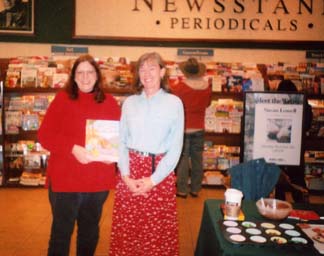![]()

Dusty Locks and the Three Bears
Author interview with Susan Lowell
Susan Lowell is a fourth generation Arizonan. She has penned several children's picture books, including The Three Little Javelinas, a Reading Rainbow book, Little Red Cowboy Hat, Cindy Ellen, Tortoise and the Jack Rabbit, Bootmaker and the Elves, winner of a Spur Award from the Western Writers of America, and Dusty Locks and the Three Bears. Ms. Lowell has also authored young adult and adult novels, and has recently finished a Southwestern cookbook Clouds for Dessert. Susan Lowell, her husband and her daughters divide their time between their home here in Tucson, Arizona and a small ranch made of stone with a tin roof in the desert near the Mexican border.
How did you get your start writing?
I was around six or seven years old and I have never stopped. When I began to read, I found it so much fun, so I thought that I would like to try writing and making books. I even tried to do some illustrations at that age, however I found myself focusing on my words rather than the pictures.
Have you ever thought about doing your own illustrations for your books?
No, I feel this is also a profession and the illustrators go through art school and are accomplished professionals that have a lot more to bring to the story. Editors usually have visions of who they want to illustrate your stories. Sometimes they may ask you your opinion but usually they choose the illustrator.
When you write a story, send it to a publisher and they send it back with re-writes, how do you feel about that?
Writing is hard work. It's like digging a big hole in the ground twice or sometimes more. However, a good editor can really help. It is really nice to have someone with experience go over the book and critique it. Sometimes, though, you have to stand up for what you think is important. "Writing is re-writing" usually things get better after they are re-written. Picture books are really special books. They are read aloud and so they have to be like a performance, paying attention to pace, suspension, interesting words and the voice of the characters.What inspired you to re-write classic children's stories into Southwestern adventures? Especially Dusty Locks?
I thought about Goldilocks and the Three Bears and thought it would be a fun tale to re-create with a southwestern twist. I played around with the idea of the story taking place up in the mountains, and using grizzly bears instead of black bears, because they were a little more ferocious. I found one of the first versions of this tale, which appears in print around 1820 by the English poet Robert Southey and I believe that it was probably inspired from an oral folktale, and then re-written for his children. It really wasn't about a golden locks little girl, but a very badly behaved little old lady. As the years progress to the mid. Victorian age, the little old lady transforms into this golden locks little girl, and that is how Goldilocks comes about. The name I use in my book is Dusty Locks. That name is based on my younger daughter Mary. Mary just didn't like her hair shampooed and we had to chase her to wash it and comb it. So we called her Dusty Locks. I also had a lot of fun finding old western expressions and comparisons to incorporate into the book.What do you like most about being a children's literature author?
I started going into schools and meeting young children and became fascinated with helping them to learn to read and reading to them. Children are an ideal audience. They are so fresh, transparent and the absorb so much. If they have questions they ask, you can tell if they are confused or if they are bored. Children need to be entertained as well as informed. That is the classic description of what literature is. The Latin word, educate means to delight and inform. Literature should be fun and exciting and as well as teach what needs to be taught. This holds true for adults as well. "I believe that a children's book ought to be like a birthday party, a fun time for all" you have pleasure but it is also informative.Do you have any advise for others that are considering writing a book and eventually getting it published?
Best advice I can give is to look out there, see what you like and what you know. Start simple and grow with it.Do you have any ideas for a new children's book?
Currently I am working on a book about quilting. It's based on a true story about a family in the western movement on a wagon train ride and how the women on the wagon train make this quilt to journal and document milestones as they travel to California. One of the characters in the story is a little girl that is learning how to sew. The actual quilt is housed in California now.What is your favorite book out of all the children's literature that you have written? Why?
All my books are like my children; I really cannot play favorites. However, I have to say that I had a lot of fun with the young children's novel "The Boy with the Paper Wings" partly because of the learning extensions in it such as how to make paper airplanes using geometry.
About the Book | Book Review | Children's Voices | Interview | Lesson Plan | About the Reviewer
